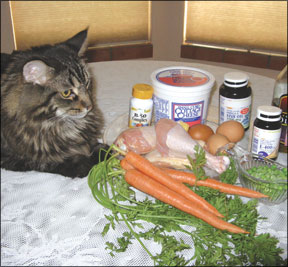You likely consider your beloved cat to be a truly unique creature, and in many respects she may indeed be one of a kind. When it comes to her dietary requirements, however, shes just like any other cat in the neighborhood – or in the world, for that matter. That is, all cats need a nutritionally sound and palatable daily diet, without which they couldnt possibly exist for very long, let alone develop their distinctively individual personalities.

Bev Caldwell
288
The lack of nutritionally complete and balanced food intake can result in a wide variety of disorders that can have lethal consequences if ignored. Daily consumption of a nutritionally adequate diet will not, of course, protect a cat from injury or from the onset of many systemic illnesses. But it is likely to supply the resources that an injured or sick animal needs in order to respond well to medical or surgical treatment.
The most readily available sources of a complete and balanced feline diet are the commercial products that can be found in just about all grocery stores and pet supply shops, says Francis Kallfelz, DVM, a professor of veterinary nutrition at Cornell Universitys College of Veterinary Medicine and a board-certified member (diplomate) of the American College of Veterinary Nutritionists.
Its also possible, he adds, for you to concoct healthy meals for your cat in your own kitchen. But if youre inclined to do so, youd better be knowledgeable about feline nutritional needs. You should also be willing to cope with the extra expense that might be involved in the preparation of your cats homemade meals.
Good Track Record
Over the past half-century or more, Dr. Kallfelz points out, the American pet food industry has striven to provide nutritionally sound, affordable and easily available canned and dry cat food. The nutritional contents of these foods are based on the nutrient requirements of cats as published by the National Research Council and/or the Cat Food Nutrient Profiles recommended by the Association of American Feed Control Officials (AAFCO). The feed control officials of the various states and the U.S. Food and Drug Administration monitor the quality of all commercial cat food products.
“In the main,” elaborates Dr. Kallfelz, “the manufacturers have done a good job of providing complete and well-balanced nutrition for companion animals. The improvements in their products during the past four or five decades have greatly benefited feline health in general and have played a major role in significantly extending the typical cats life span.”
Despite this estimable track record, some cat owners embrace the notion that they can do a better job than the pet food industry by creating their own diets. Their reasons range widely, Dr. Kallfelz notes. Some owners, for example, have become convinced, erroneously, that commercial cat food is tainted with foul ingredients and dangerous preservatives; others may feel that the cost and inconvenience of preparing a homemade diet is justified if the end product contains only “natural” ingredients.
A Delicate Balance
Dr. Kallfelz strongly doubts that owners can improve on commercial cat foods in their own kitchens. For those who insist on concocting homemade diets, he urges that they do so only in consultation with their primary-care veterinarian or a veterinary nutritionist. An adequate feline diet must provide proper amounts as well as a proper balance of proteins, minerals, fats and vitamins, he points out, and scientists have devoted decades to establishing the optimal balance. “Unless he or she is knowledgeable regarding feline nutrition,” says Dr. Kallfelz, “its almost impossible for the typical cat owner to formulate a diet that is complete and properly balanced.”
He cites, for example, a cats vitamin requirements. Vitamins are water- or fat-soluble organic substances that exist naturally in plant and animal foods and are needed in small amounts for the growth and normal functioning of the feline body. A vitamin A deficiency can retard bone development and cause eye disorders, lack of coordination, brain damage and other serious health issues.
On the other hand, explains Dr. Kallfelz, there can be an excess of this important vitamin in the diet. “A cat can get a vitamin A toxicity by eating a diet that is too high in certain types of liver or cod liver oil, which can cause bone deformities, liver disorders, neurologic dysfunction and other problems.”
Another example: Proteins, which are major components of the supporting structure in a cats body – the muscles, ligaments and tendons, for example – are composed of chains of smaller chemical compounds called amino acids. A cats body needs about 20 different amino acids in order to function properly. Half of these can be synthesized within the body, but the remainder – the essential amino acids – cannot, and thus must be provided in the diet.
Several decades ago, says Dr. Kallfelz, a serious deficiency of the amino acid taurine was identified in the feline population. Taurine deficiency was responsible for serious diseases of the heart, eyes and reproductive system. This problem almost never occurs among domestic cats today, however, since cat food manufacturers now supplement their products with adequate amounts of taurine.
Seek Expert Input
Could the creator of a homemade diet ensure that it contained the proper level of taurine or the appropriate dietary balance of vitamin A? Not without the guidance of a veterinary professional, says Dr. Kallfelz.
“If youre determined to create your cats meals at home,” he advises, “you need this expert assistance. Consult your veterinarian. If he or she is not equipped to provide that assistance, then you should see a veterinary nutritionist.”

